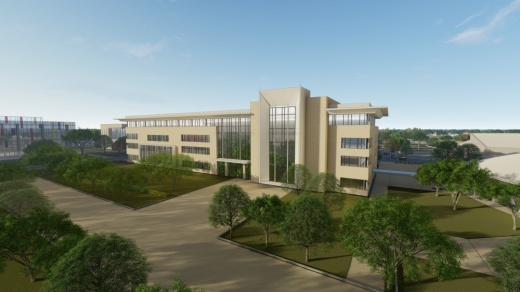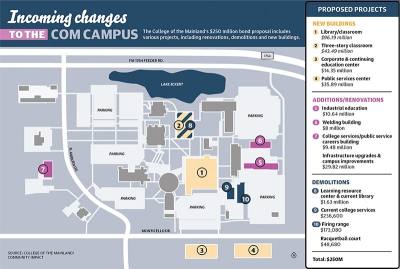Despite national setbacks from the COVID-19 pandemic, thousands of students are expected to enroll in colleges and universities over the next few years in the Gulf Coast region, which includes Houston, according to enrollment forecasts from the Texas Higher Education Coordinating Board. In fact, COM has almost returned to its prepandemic levels of enrollment and expects to continue growing, Vice President of Instruction Jerry Fliger said.
“Galveston County is one of the fastest-growing counties,” said Diane Burkett, COM’s executive director of marketing and public affairs. “As a result, more residents and companies are relocating into the region, resulting in more demand for expanded programs and increased student enrollment.”
COM plans to hold its $250 million bond election May 6, which was unanimously approved by the COM board of trustees Jan. 23. The bond program is the biggest the college has ever proposed and would address a variety of items, including college programs, old facilities, infrastructure needs and safety.
Meanwhile, UHCL plans to hold a student referendum for students to vote and approve or deny increased student fees that would go toward funding a new dedicated student center that could cost anywhere from $49 million to $60 million. Following the referendum, the university would need approval from the University of Houston board of regents and would take the request to the 2025 Texas legislative session, said Mark Denney, UHCL vice president of administration and finance.
While COM’s possible bond program needs Bay Area residents to vote as they would pay for the bond, UHCL will require the input of students. Students will have to decide whether the referendum is approved, even though it is unlikely a new student center would be built before their graduation.
COM’s record bond
As part of COM’s comprehensive 10-year plan to expand program offerings and accommodate future growth, the Texas City-based community college has proposed a record $250 million bond program. League City and Friendswood are in the service area of COM, but residents are unable to vote on any COM bonds as they are not part of the taxing district, Fliger said.
The proposed May bond will go toward the construction of a new library and classroom building; a corporate and continuing education center; a public services center; a three-story classroom building; and general infrastructure improvements, such as parking lot improvements to reduce flooding and blue light emergency call-boxes, Fliger said.
“Many of the remaining structures on campus are [over] 50 years old,” Burkett said. “They are physically in poor shape, costly to maintain, don’t provide modern-day learning spaces and present significant concerns from a safety and accessibility standpoint.”
Furthermore, additions and renovations are planned for the Welding Building, the Public Services Career Building and the Industrial Education Building. However, the bond program also calls for the demolition of the Learning Resources Center, College Services Building, racquetball court and firing range building.
The college has historically had only three prior bond programs in its 57-year history since it was founded in 1966, Fliger said.
COM held its most recent bond election in November 2018, which passed with a 65% approval, Vice President for Fiscal Affairs Clen Burton said. The bond led to the construction of the STEAM/Allied Health Building, Industrial Careers Building and Student Success Building along with renovations and demolitions.
“Those [buildings] were to address years of needs for infrastructure,” Fliger said. “We had programs we needed to add, for example, radiology and dental hygiene, but we had no place to put them.”
The 2018 bond program completed the first phase of the college’s 10-year plan, while the proposed 2023 bond program is expected to complete that plan.
“Regional growth, aging facilities and campus safety are three primary drivers of why COM is pursuing another bond election in May 2023,” Burkett said. “The facilities COM built from the 2018 bond included additional ‘shell’ space in its architectural designs to ensure the college would have room to grow.”
The interest and sinking tax rate for taxpayers in the Dickinson, Hitchcock, Santa Fe and Texas City ISDs would increase by an annual cost of $281.04 to a total annual cost of $379.20 for houses valued at $300,000, Burton said.
“Before 2018, [the I&S tax rate] was zero; we did not have any bonds on our buildings,” Burton said.
The college does not have plans for new bonds in the near future, following approval, Fliger said.
“If the bond doesn’t pass, then these are services that we won’t be able to deliver,” Fliger said.
UHCL student referendum
UHCL currently utilizes only one-third of the Student Services and Classroom Building as a student center space but plans to hold a referendum this spring to approve or deny increased student fees to fund the construction of a new standalone student center building to better serve students.
“We outgrew that space probably 10 years ago,” Denney said. “It hasn’t served our campus and really hasn’t served us since ... we started accepting freshmen.”
The student center currently offers space for student meetings, organizations and a veteran’s service center. However, a dedicated student center could also offer a dining option, ballroom-style space and even possibly a gaming center, Denney said.
“There is no specific deadline [for the student center] but instead a series of approvals that need to be met,” Denney said.
Education and general facilities such as classroom and administrative buildings for public universities are funded by the state of Texas, whereas auxiliary facilities such as the university’s Campus Recreation and Wellness Center and the proposed new student center must be funded by the university, Denney said.
Most of the funds to repay bonds for a new student center building would come from an increase to the student center fee; the current fee of $30 per student each semester is insufficient, but any increase above 10% requires a referendum. The referendum proposes raising the maximum student fee to $150; however, the university plans to levy a fee of $115-$120 similar to the recreation and wellness center fee, Denney said. The referendum is scheduled to happen in the week of April 17, Denney said.
“This is a discussion we are having with our students, as they would need to agree that the construction of a new student center would in fact better serve our students,” Denney said. “Especially in recognition that our current students will have graduated by the time a new student center is constructed and operating, this would be a benefit for future students.”
UHCL’s last completed bond project was construction of the Hunter Residence Hall, which was approved in 2017 and opened in fall 2019. The bond proceeds totaled $22 million, Denney said.
Previously, the university surveyed students in November 2022 on whether they would support a student center fee increase for the sake of building a new student center. Then, in January, the university surveyed students for their preferences on three different fee raise options. Over 1,000 students responded to the November survey, and about 70% showed support, Denney said.
If the new student center is approved by all involved parties, then the university expects to break ground on construction sometime in 2027 or 2028, Denney said.The College of the Mainland’s $250 million bond proposal includes various projects, including renovations, demolitions and new buildings.







